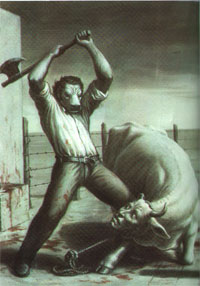Yoga dictionary. Prakriti
 There is such a thing as Prakriti in the philosophy of the Sankhya school. The term is also mentioned in the Yoga sutras of Patanjali. Prakriti is considered to be the feminine aspect of the manifestation of the Universe, which in symbiosis with the masculine aspect of the Universe — Purusha — forms the universe.
There is such a thing as Prakriti in the philosophy of the Sankhya school. The term is also mentioned in the Yoga sutras of Patanjali. Prakriti is considered to be the feminine aspect of the manifestation of the Universe, which in symbiosis with the masculine aspect of the Universe — Purusha — forms the universe.
Prakriti in Sanskrit means ’cause`, `matter`or ‘nature’. Prakriti is the primordial nature, the first principle of the world. When Prakriti is not influenced by the gunas, it remains in its original state. And the moment the gunas begin to affect Prakriti, the balance of the gunas is disturbed, and Prakriti begins to change — to take different forms and form the material world.
Patanjali writes in Sutra 45 of Chapter one about how to see the primordial essence of all things and phenomena outside of forms. In the version of the translation Svensson Sutra reads: “the Area ends with a thin clean cloth that does not have the features or the Linga”. That is, as the knowledge of the world through contemplation or Dhyana, a person begins to see the true essence of things and phenomena and begins to perceive them as identical with each other and inseparable from each other.
Swami Satyananda Saraswati translated this Sutra a little differently: “the Stages of Samadhi in relation to subtle objects extend up to Prakriti.” Thus, achieving the state of Samadhi allows you to see the original essence of things. And the deeper the stage of Samadhi, the more the true level of perception of reality opens before a person.
In his treatise, Patanjali regards Prakriti as the ultimate goal, that is, the final stage of Samadhi leads to the knowledge of Prakriti. In translation 45 the Sutra version Zagumennova this is stated quite clearly: “the Scope of thin ends in the unmanifest.” The subtle sphere is the process of cognizing the world through the practice of Dhyana, and the unmanifested is Prakriti, which under the action of the gunas, taking different forms, generates everything.
Considering such a concept as Prakriti, one should pay attention to the concept of the influence of the gunas. It is under the influence of the gunas that Prakriti forms the material world and creates the illusion of duality and independence of things and phenomena from each other.
In Sutra 19 of Chapter two, Patanjali writes in detail about the gunas. In A. Bailey’s version of the translation, this Sutra reads as follows:”the Divisions of the gunas (or qualities of matter) are Quaternary: specific, nonspecific, specified and inviolable.” The three gunas-Tamas, rajas and sattva-are also inconstant and ambiguous in their manifestation. And can be in a clearly manifested or, on the contrary, indefinite state, as well as-barely manifested or completely devoid of signs.
Thus, Prakriti is the primordial matter of the Universe, the starting point from which the vector of development arises. When the qualities of Prakriti (guna) are in balance, Prakriti remains in its original state. When this balance is disturbed, when the gunas are out of balance, Prakriti begins to change, under the influence of the Purusha (spirit), which is the male aspect of the Universe.
In the process of Prakriti transformation, the cosmic consciousness or Mahat first arises, which has only the capacity to be aware of existence and what is happening. Further, the process of transformation of Prakriti leads to the state of Buddhi, at this stage the consciousness is able to recognize and feel. Further, as Prakriti becomes coarser, the individual soul arises, acquires the conditioned mind and begins to accumulate experience.
The concept of Prakriti transformation is reflected in Ayurveda. The term Prakriti there refers to the original nature of man, and instead of the concept of balance of the gunas in Ayurveda is considered the balance of the doshas. The balance of the doshas is a state of human health. The prevalence of any one dosha creates a tendency to certain diseases.




